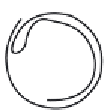Biology Reference
In-Depth Information
Keith Waddington and colleagues studied the round dance of bees
that is performed when bees forage close to the nest. h ey found that
the number of reversals of the dance per minute and the duration of the
dance correlated with the calories gained by foragers attending artii -
cial feeders. Calories gained were directly related to sugar concentra-
tion delivered at the artii cial l ower. Properties of the sound produced
by round dances also changed with sugar concentration.
Waddington and Mindy Nelson presented high- and low-quality
pollen at feeders within a cage. (Pollen can be collected from colonies
in large quantities and then fed back during periods of pollen dearth.
Returning foragers are forced to pass through a wire grid that is slightly
bigger than their bodies. h e grid knocks of the pollen loads, which
then fall into a collection tray. h e pollen pellets are harvested and usu-
ally frozen fresh or dried for storage.) Low-quality pollen was freshly
ground (in a cof ee grinder) pollen that was adulterated with alpha cel-
lulose, an inert solid substance that bees can collect. h e high-quality
pollen was unadulterated. Bees were more likely to perform round
dances (Figure 2.13) and to dance faster (more 180 degree turns per
minute) when they were foraging on higher-quality pollen. Once again
the response showed a suprathreshold component and was demon-
strated to be analog rather than binary.
< 20m
> 100m
Figure 2.13.
Honey bee foragers do recruitment dances on the vertical surface
of a comb at er they return from foraging trips. h e shape of the dance changes
with the distance to the source up to about 100 meters, depending on the
geographic population of the bees. Typically they perform a round dance, let , to
indicate a source close to the nest and a full-formed waggle dance to indicate a
source about 100 meters or more distant. h e arrows show the direction of body
movement for the dances.






















